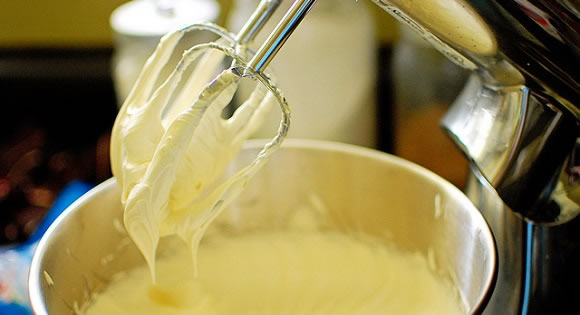Want to start baking some healthy plant-based treats at home? This guide will tell you everything you need to know about baking without butter, eggs, milk or oil - so you can have your cake, and eat it too!

If you're an avid baker, then you'll know that most traditional baked goods include pretty generous amounts of butter, milk, and / or eggs. So does going plant-based have to mean sacrificing your sweet tooth altogether? Definitely not! While we don't really recommend feasting on sweets and desserts every day, there's definitely a time and a place for them. Whether it's for a birthday party or a morning tea at the office, baking is an opportunity to show others just how delicious healthy plant-based food can be!
The big question is, how do you go about replacing those animal ingredients? There are several options to choose from, but it will depend largely on the type of product you are making. Learning which ingredient works with what recipe is often a process of trial and error, but with a little practice, you'll soon be a substitution pro! To get you started, here are some basic tips for substituting the butter, oil, milk, eggs and white flour in everyday baking recipes.
Replacing Butter or Oil
In regular vegan baking, the butter used in traditional recipes is often replaced with a vegetable margarine or oil. But when eating whole foods plant-based, you should aim to eliminate these two products all together.
Instead, unsweetened applesauce can be used as an oil substitute in most cakes and muffins. Use 1/3 of a cup of applesauce for every 1/2 cup of oil or margarine. You can also use applesauce in soft-baked cookies and biscuits, but it will not help you achieve the right consistency in crispy or thin cookies.
Roasted nut or seed butters can also be used, and these will work especially well in cookies. Remember to look for varieties that have no added oil or sugar. Use an equal amount of nut butter to replace the margarine or oil in a recipe. If it's very thick or stiff, stir in one or 2 tablespoons of soy milk before using. I tend to favor cashew butter as it has a very subtle flavor, but sunflower and almond butters also work well.
Another great option for replacing oil is 'aqua faba'. This is the liquid from canned chickpeas or white beans. The flavour is actually surprisingly neutral, and the consistency is very similar to that of vegetable oil. Use an equal amount of aqua faba to replace the oil in a recipe.
Replacing Milk
This is probably the easiest of all ingredients to replace. You can choose from soy milk, rice milk, almond milk, hazelnut milk, or any just about any other plant-based milk you like. If you are catering for allergies, rice milk is probably the best option, as it is both soy and nut-free (but be sure to check the label!)
If a recipe calls for buttermilk, that's no problem either. For every 1 cup of buttermilk, use 1 cup of soy milk whisked together with 1 teaspoon of cider vinegar. Set the mixture aside for a few minutes before using. You'll notice it thickens and curdles slightly, and what you now have is a liquid that has a flavor and consistency similar to buttermilk. This is great for using in scones, pancakes and "buttermilk" biscuits.
Replacing Eggs
Replacing eggs in a recipe can either be incredibly easy or impossible, depending on what you're trying to make. There are several options, each of which will work well in different recipes.
Ground Flax Seeds: Combine 1 tbsp. of ground flax seed with 3 tbsp. of water to substitute for 1 egg. This option is best for earthy-flavored baked goods like fruit muffins, oatmeal cookies and carrot cake.
Mashed Banana: 2-3 tbsp. of mashed banana will work as an egg replacer in your baked goods. It's best for things that are supposed to taste like banana (unsurprisingly) but will also work well in muffins, breads and cookies that contain other fruits.
Soy Yogurt: Recommended for dense products like brownies or fudge cake, rather than delicate or airy ones. Use 3 tbsp. of plain unsweetened soy yogurt to replace 1 egg.
Powdered Egg Substitutes: Powdered egg replacers can be purchased from most health food stores. Follow the directions on the packet in order to make the required amount of egg substitute. (I find that they work great for cookies, but prefer to use flax or banana in other recipes.)
Aqua Faba: This is the brine found in a can of chickpeas or white beans. It might sound strange, but it doesn't impart any bean-y flavour at all! Buy canned legumes that have no salt added, and substitute 3 tbsp. of aqua faba for each egg in a recipe.
Nothing: Sometimes, if a recipe only calls for a single egg, I don't bother trying to replace it. If you're already using a leavening agent such as baking soda or baking powder, this will add air to the product. You can simply add a touch more liquid (water or soy milk) to the batter to achieve the right consistency.
Replacing White Flour
No, it's not an animal product, but white flour is a highly processed product, so it's best to avoid using it whenever possible. Opt for whole grain flours, such as whole wheat and whole spelt, instead. If it's a special occasion, or regular whole wheat flour is too dense for the item you're baking, try using white whole-wheat flour instead. You can also try gluten-free flours if wheat allergies are an issue. Buckwheat, brown rice, millet and chickpea flours are becoming increasingly available. You can experiment with different combinations to see which flours work best for different recipes.
Looking for recipes to get you started? Then head on over to our baking section.
Article photo courtesy of Jamiesrabbits via Flickr
